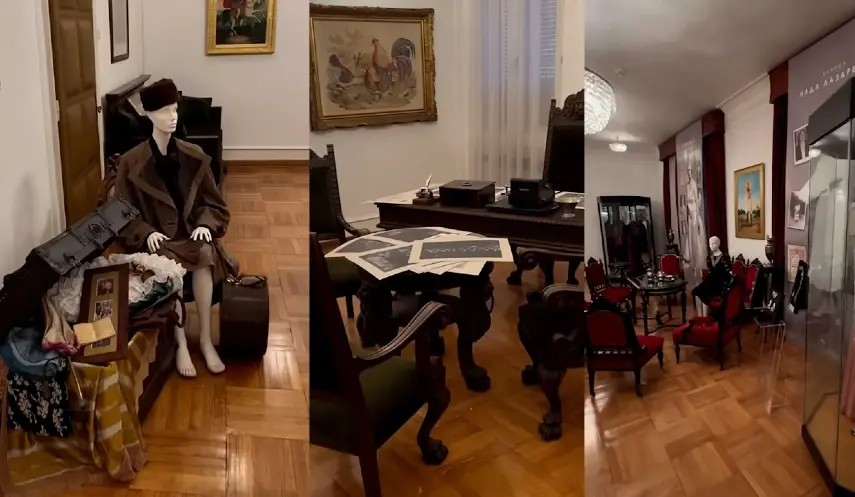PALACE OF VRBAS' BANS – LURE FOR TOURISTS FROM ALL OVER THE WORLD
Republika Srpska - Banja Luka - sights /6/
06/07/2025
10:00

BANJA LUKA, JUNE 7 /SRNA/ - Although the only granddaughter of the last ban of the Vrbas Banate, Nadežda Lazarević-Kovačević did not live in the Banski Dvor /the Ban's Palace/ in Banja Luka, she worked there at RTRS, which was originally located in this very building as Serbian Radio and Television.
She walked through the rooms of Banski Dvor, as her colleagues would say, just as if she belonged there, as if she knew all the rooms, some secrets, and just as if she were at home.
Lazarević-Kovačević "breathed" the Lazarević family into that house, Banski Dvor, with a time-traveling permanent exhibition "Vrbas Banate - Outlines, Traces, Echoes..."
Representative in its content, representative of the cultural history of Banja Luka, the exhibition removes the historical dust from the most prosperous period in the development of the city and Krajina, introducing visitors to a nostalgic journey into a not-so-distant time, which seems unreal, almost like a fairy-tale.
She has woven memories, exhibits, time, love into the exhibition - she knows it, but even today she comes back to visually revive the spirit of that time that still lives with her and within her.
"Of course, I come by occasionally, not that often; more to visit my house where I was born, which is no longer there. It was demolished in 1984 due to the construction of the `Pentagon` housing estate. Most of the exhibits on display have been a part of my life since I can remember. There are the energies of people I loved very much and whose love is still, as I like to say, my atomic shield today," said Lazarević-Kovačević.
She points out that the exhibition is the work of her husband Dragan Kovačević, whose dream it was, and who also heads the Foundation "Dr Todor Lazarević, Ban of the Vrbas Banate".
Dragan Kovačević told SRNA that today the western part of Republika Srpska rests precisely on the area of the Vrbas Banate /1929-1941/, in which more than 600,000 Serbs lived and where the Serb population was in the majority.
The opening of the exhibition, says Kovačević, has revealed a significant cultural asset that exists in Banja Luka, which was not available to the public and researchers, especially young people, allowing them to learn what true values are and how to achieve them.
"Today's generations have a rare opportunity to visit the exhibition, through the culture of remembering the best of the past, to revive their awareness of themselves, their origins and traditions," said Kovačević.
Unlike Nadežda, her husband is in Banski Dvor almost every day, ready to tell visitors the story of the banate in an inspiring way, and guide them through the building and the exhibition.
"Since the house of Dr Todor Lazarević was demolished, we are grateful to the director of the Banski Dvor for recognizing the importance and enabling Banja Luka to receive an exhibition like the one in the Grujić-Šećerović house in Belgrade, the Despić house in Sarajevo and similar ones in the surrounding area, which is common for the cultural offer of European cities," he said.
Kovačević noted that the exhibition was very well attended, and that the Book of Impressions even contains messages written in Arabic.
"Regardless of whether it was the local population or tourists, everyone was amazed by what they saw. They neither knew nor expected that it existed in Banja Luka. This is evidenced by the wonderful entries in the Book of Impressions, written in all the languages of the former Yugoslavia, but also in English, French, German, Italian, and even Chinese and Arabic. We are especially happy that Princess Jelisaveta Karađorđević also visited the exhibition with enthusiasm," said Kovačević.
Commenting on the exhibition, Dr Duško Pevulja emphasized that it was a true feat to preserve the objects in the turbulent decades of the 20th century, but also a sign of the national and civic consciousness of a family.
"Giving these items to their fellow citizens in this way, as Nadežda Lazarević-Kovačević and her husband Dragan Kovačević do, is an indicator of the same awareness and a rare example of selflessness in our time, which looks at the world exclusively through the lens of its own material benefit. Both of them are aware that the paths of a distinguished family, at the highest stage of its development, are naturally woven into the collective being of their own people," said Pevulja.
Nadežda Lazarević-Kovačević wrote the books "Like a Beautiful Dream" and "DirižaBL" on the desk of her grandfather, the last Ban Dr Todor Lazarević, and then on the desk of her father Predrag Guga Lazarević, a Serbian writer whose bust stands in front of the National Theater of the Republika Srpska, which testify to that somewhat forgotten period, the golden age of civic Banja Luka, the splendor of which is also depicted in this series. /to be continued/

GOLDSCHMIDT: STILL WAITING FOR APOLOGY FROM BiH AUTHORITIES

POSSIBLE COOPERATION BETWEEN ALMAZOV RESEARCH CENTRE AND UNIVERSITY CLINICAL CENTRE

SARAJEVO "TROIKA" WANTS TO WEAKEN SNSD - THE BIGGEST OBSTACLE TO UNITARY BiH



